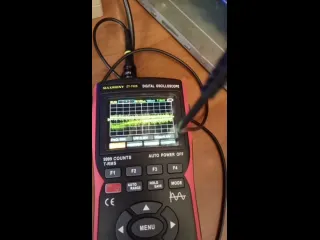Symphony7526 mozart symphony no 40 in g minor k 550 with score
0.09 K views
0
0
About
Загружено автоматически через бота оригинал видео данное видео является собственностью канала symphony7526. оно представлено в нашем сообществе исключительно в информационных научных образовательных или культурных целях. наше сообщество не утверждает никаких прав на данное видео. пожалуйста поддержите автора посетив его оригинальный канал если у вас есть претензии к авторским правам на данное видео пожалуйста свяжитесь с нами по почте support и мы немедленно удалим его.
оригинальное описание
wolfgang amadeus mozart
symphony no. 40 in g minor k. 550 with score
composed 1788
orchestra danish national chamber orchestra
conductor adam fischer
0000 1. molto allegro g minor
0716 2. andante eflat major
1631 3. menuetto. allegretto g minor trio g major
2027 4. allegro assai g minor
mozart composed his final three symphonies during the summer of 1788. his entries in the thematic catalog he maintained suggest that all were written during the space of about two months. much critical discussion has been devoted to the reasons for their composition for it appeared that mozart had no specific occasion in mind for their performance. the romantic notion that he composed them without practical purpose is now widely disregarded as being out of character with mozarts known compositional procedures and the scholar h. c. robbins landon has recently advanced convincing arguments to suggest that they were in fact written for a series of concerts he gave in the fall or advent season of 1788. robbins landons argument is largely based on an undated letter written by mozart to his principal benefactor his fellow freemason michael puchberg. in this letter he refers to his concerts which will begin next week concerts which scholars formerly believed never to have taken place. evidence also supports the idea advanced by neal zaslaw that mozart took the three symphonies on the tour he made to germany the following year which would further undermine the longheld notion that the composer never heard three of the greatest works in the symphonic literature performed.
one aspect of the symphonies upon which commentators reach universal agreement is their extraordinary diversity of character each has unique qualities which together utterly explode the myth that the extreme agitation and pathos of the g minor symphony reflected the abject circumstances in which mozart found himself at this period. the begging letters addressed to puchberg during these months are indeed pitiful documents that might be cited as evidence of mozarts state of mind at the time he was composing the g minor symphony. but they will hardly do for the mellow warmth strength and humor of e flat symphony or the elevated grandeur of the jupiter symphony. neither should it be forgotten that the tragic qualities so often associated with the symphony today have not always been apparent to all. to robert schumann the symphony was a work of grecian lightness and grace while for a later writer alfred einstein there are passages that plunge to the abyss of the soul.
such ambiguity is perhaps apt for one of the greatest works of a composer whose music so frequently defies adequate description. the symphony is cast in the usual four movements the opening molto allegro immediately announces something unusual by starting not with characteristic loud call to attention but with quietly spoken agitation. the uneasy passion of the main theme leads to conclusions that seem to protest rather than find any consolation. the movements dominant feeling is urgency upbeat after upbeat after upbeat occurs. amid great instability and a questioning aura we experience a peek into don giovannis abyss. in the finale the horns intrude with wild swatches of color. there is even an eerie twelvenote insertion after the double bar in the allegro assai section.
there are two versions of the g minor symphony. the first is modestly scored for flute and pairs of oboes horns and strings but at some point shortly after composition mozart added parts for two clarinets slightly altering the oboe parts to accommodate them. such second thoughts surely also add credibility to the idea that mozart led performances of the work he would hardly have bothered with such refinements if the symphony was not being used for practical purposes.
all music guide
1st version without clarinet with score
article
mozart
international music score library project imslp
mozart2cwolfgangamadeus
оригинальное описание
wolfgang amadeus mozart
symphony no. 40 in g minor k. 550 with score
composed 1788
orchestra danish national chamber orchestra
conductor adam fischer
0000 1. molto allegro g minor
0716 2. andante eflat major
1631 3. menuetto. allegretto g minor trio g major
2027 4. allegro assai g minor
mozart composed his final three symphonies during the summer of 1788. his entries in the thematic catalog he maintained suggest that all were written during the space of about two months. much critical discussion has been devoted to the reasons for their composition for it appeared that mozart had no specific occasion in mind for their performance. the romantic notion that he composed them without practical purpose is now widely disregarded as being out of character with mozarts known compositional procedures and the scholar h. c. robbins landon has recently advanced convincing arguments to suggest that they were in fact written for a series of concerts he gave in the fall or advent season of 1788. robbins landons argument is largely based on an undated letter written by mozart to his principal benefactor his fellow freemason michael puchberg. in this letter he refers to his concerts which will begin next week concerts which scholars formerly believed never to have taken place. evidence also supports the idea advanced by neal zaslaw that mozart took the three symphonies on the tour he made to germany the following year which would further undermine the longheld notion that the composer never heard three of the greatest works in the symphonic literature performed.
one aspect of the symphonies upon which commentators reach universal agreement is their extraordinary diversity of character each has unique qualities which together utterly explode the myth that the extreme agitation and pathos of the g minor symphony reflected the abject circumstances in which mozart found himself at this period. the begging letters addressed to puchberg during these months are indeed pitiful documents that might be cited as evidence of mozarts state of mind at the time he was composing the g minor symphony. but they will hardly do for the mellow warmth strength and humor of e flat symphony or the elevated grandeur of the jupiter symphony. neither should it be forgotten that the tragic qualities so often associated with the symphony today have not always been apparent to all. to robert schumann the symphony was a work of grecian lightness and grace while for a later writer alfred einstein there are passages that plunge to the abyss of the soul.
such ambiguity is perhaps apt for one of the greatest works of a composer whose music so frequently defies adequate description. the symphony is cast in the usual four movements the opening molto allegro immediately announces something unusual by starting not with characteristic loud call to attention but with quietly spoken agitation. the uneasy passion of the main theme leads to conclusions that seem to protest rather than find any consolation. the movements dominant feeling is urgency upbeat after upbeat after upbeat occurs. amid great instability and a questioning aura we experience a peek into don giovannis abyss. in the finale the horns intrude with wild swatches of color. there is even an eerie twelvenote insertion after the double bar in the allegro assai section.
there are two versions of the g minor symphony. the first is modestly scored for flute and pairs of oboes horns and strings but at some point shortly after composition mozart added parts for two clarinets slightly altering the oboe parts to accommodate them. such second thoughts surely also add credibility to the idea that mozart led performances of the work he would hardly have bothered with such refinements if the symphony was not being used for practical purposes.
all music guide
1st version without clarinet with score
article
mozart
international music score library project imslp
mozart2cwolfgangamadeus
Related videos
Recent Trends
 HD
HD
 HD
HD
 HD
HD
 HD
HD
 HD
HD
 HD
HD
 HD
HD
 HD
HD

 HD
HD
 HD
HD
 HD
HD
 HD
HD

 HD
HD
 HD
HD
 HD
HD
 HD
HD
 HD
HD

 HD
HD
 HD
HD
 HD
HD
 HD
HD